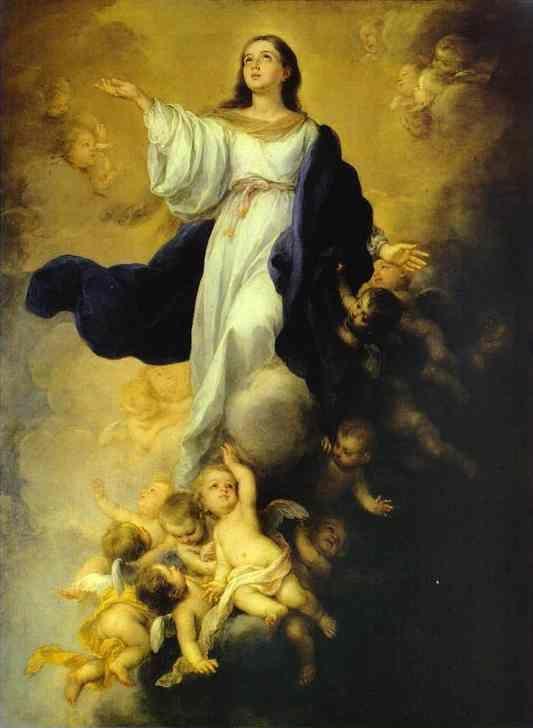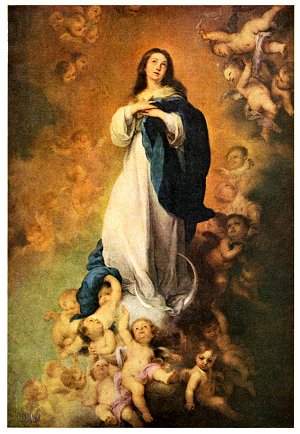| Please explain our Catholic belief in the Assumption of the Blessed Mother. Addressing a jubilant crowd of more than 500,000 people packed into St. Peter's Square, Pope Pius XII solemnly defined in "Munificentissimus Deus" on Nov. 1, 1950, that the "Immaculate Mother of God, the ever-virgin Mary, having completed the course of her earthly life, was assumed body and soul into heavenly glory." Although the solemn definition may have been at the midpoint of the 20th century, the belief in the Assumption of our Blessed Mother exemplifies the dynamism of revelation and the Church's ongoing understanding of it as guided by the Holy Spirit. Granted, the word Assumption does not appear in Sacred Scripture. For this reason many fundamentalists who literally interpret the Bible would have a difficulty with this belief. Nevertheless, we must first pause and reflect on the role of our Blessed Mother in the mystery of salvation, for this provides the foundation for the belief in the Assumption. We firmly believe that from the first moment of her conception Mary was free of all sin, including Original Sin, by a special favor of almighty God. The Archangel Gabriel recognized her as "full of grace," "blessed among women" and "one with the Lord." Mary had been chosen to be the Mother of our savior. By the power of the Holy Spirit, she conceived our Lord Jesus Christ, and through her, true God became also man, "The Word became flesh and dwelt among us." During her lifetime, although the Gospel citations are limited, Mary always presented our Lord to others: to Elizabeth and her son, John the Baptist, who leapt for joy in the womb at the presence of the Lord still in his own mother's womb; to the simple shepherds as well as the wise Magi; and to the people at Cana, when our Lord acquiesced to His mother's wish and performed the first miracle. Moreover, Mary stood at the foot of the cross with her Son, supporting Him and sharing in His suffering through her love as only a mother could do. Finally, she was with the Apostles at Pentecost, when the Holy Spirit descended and the Church was born. Therefore, each of us can step back and see Mary as the faithful servant of God who shared intimately in the birth, life, death and resurrection of our Lord. For these reasons we believe that the promises our Lord has given to each of us of sharing eternal life, including a resurrection of the body, were fulfilled in Mary. Since Mary was free of Original Sin and its effects (one of which is corruption of the body at death), since she shared intimately in the life of the Lord and in His passion, death and resurrection, and since she was present at Pentecost, this model disciple appropriately shared in the bodily resurrection and glorification of the Lord at the end of her life. (Note that the solemn definition does not specify whether Mary physically died before being assumed or just was assumed; it simply states, "Mary, having completed the course of her earthly life...") The <Catechism>, also quoting the Byzantine Liturgy, states, "The Assumption of the Blessed Virgin is a singular participation in her Son's resurrection and an anticipation of the resurrection of other Christians: 'In giving birth you kept your virginity; in your Dormition you did not leave the world, O Mother of God, but were joined to the source of Life. You conceived the living God and, by your prayers, will deliver our souls from death'" (No. 966). The belief in the Assumption of our Blessed Mother has been longstanding in our Church. We must remember that the early Church was preoccupied with resolving questions about Christ, particularly His incarnation and the hypostatic union (His divine and human natures). However, in addressing these questions, the Church gradually defined the titles of Mary as Mother of God and as New Eve, and the belief of the Immaculate Conception, all of which form the basis for the Assumption. In "Munificentissimus Deus," Pope Pius XII cited various Church Fathers to trace the longstanding tradition of the belief of the Assumption—St. John Damascene, St. Andrew of Crete, St. Modestus of Jerusalem and St. Gregory of Tours, to name a few. Bishop Theoteknos of Livias (c. 550-650) delivered one of the most comprehensive early sermons concerning the Assumption: "For Christ took His immaculate flesh from the immaculate flesh of Mary, and if He had prepared a place in heaven for the Apostles, how much more for His mother; if Enoch had been translated and Elijah had gone to heaven, how much more Mary, who like the moon in the midst of the stars shines forth and excels among the prophets and Apostles? For even though her God-bearing body tasted death, it did not undergo corruption, but was preserved incorrupt and undefiled and taken up into heaven with its pure and spotless soul." St. John Damascene (d. 749) also recorded an interesting story concerning the Assumption: "St. Juvenal, Bishop of Jerusalem, at the Council of Chalcedon (451), made known to the Emperor Marcian and Pulcheria, who wished to possess the body of the Mother of God, that Mary died in the presence of all the Apostles, but that her tomb, when opened upon the request of St. Thomas, was found empty; wherefrom the Apostles concluded that the body was taken up to heaven." In all, the Patristic Fathers defended the Assumption on two counts: Since Mary was sinless and a perpetual virgin, she could not suffer bodily deterioration, the result of Original Sin, after her death. Also, if Mary bore Christ and played an intimate role as His mother in the redemption of man, then she must likewise share body and soul in His resurrection and glorification. The Byzantine Emperor Mauritius (582-602) established the celebration of the Dormition of the Blessed Virgin Mary on August 15 for the Eastern Church. (Some historians speculate that the celebration was already widespread before the Council of Ephesus in 431). By the end of the 6th century, the West likewise celebrated the Feast of the Assumption. While the Church first emphasized the death of Mary, gradual shifts in both title and content occurred so that by the end of the 8th century, the Gregorian Sacramentary had prayers for Assumption Day. The Feast of the Assumption gives each of us great hope as we contemplate this one facet of the beautiful woman of faith, our Blessed Mother. Mary moves us by example and prayer to grow in God's grace, to be receptive to His will, to convert our lives through sacrifice and penance, and seek that everlasting union in the heavenly Kingdom. In 1973, the National Conference of Catholic Bishops, in their letter "Behold Your Mother," stated, "Christ has risen from the dead, we need no further assurance of our faith. Mary assumed into heaven serves rather as a gracious reminder to the Church that our Lord wishes all whom the Father has given Him to be raised with Him. In Mary taken to glory, to union with Christ, the Church sees herself answering the invitation of the heavenly Bridegroom." Fr. Saunders is pastor of Queen of Apostles Parish and president of Notre Dame Institute, both in Alexandria. |






